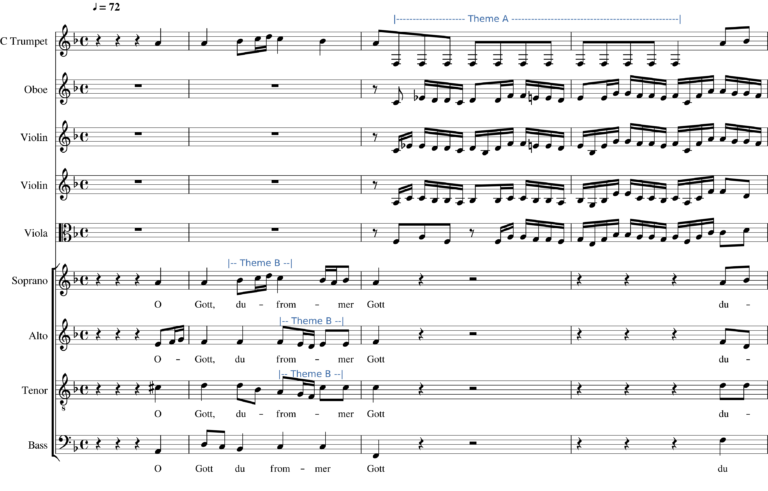Playlist
Translation
| German Text | English Text |
|---|---|
| German Text | English Text |
Analysis
This is one of those cantatas where the words have very little to do with the prescribed readings for the day! Whereas the Gospel is all about not rushing to judgement, lest you be judged in turn, the Neumeister-sourced libretto is all about being good, wholesome, honest and of pure conscience -which are, apparently, especially Germanic virtues! (Fair enough: Wagner says much the same sort of thing at the end of Meistersinger. It’s a hint of nationalist chauvinism that doesn’t sit particularly well in the post-1945 world so much, however). In any event, the central, choral, movement of the Cantata is about as close as we get to the Gospel: ‘do unto others as you would they do unto you’ versus ‘judge not lest ye be judged’. Close enough, I guess…
Frankly, it’s an insipid libretto and convention has it (see Dürr, p.420 for example) that Bach was probably in a bit of a rush, unable to come up with something better, and thus resorted to an old text that had been published some ten years earlier. It was, after all, one of his earliest compositions for his new post as Cantor at Leipzig’s Tomaskircher: it is conceivable he was trying to impress, given the newness of the job… and that he was snowed under with all his new duties.
From the technical perspective, the cantata is architecturally symmetrical: Aria-Recit-Chorus-Recit-Aria and then a concluding Chorale. The two recitatives balance each other out, too: a gentle Tenor praise of Honesty and a stormy Bass condemnation of Hypocrisy. Similarly, we have the Alto Aria complemented by a Tenor one: both are similarly paced, both are thinly orchestrated (a couple of violins for the Alto, a couple of oboe d’amore for the Tenor) and each praising the virtues of a pure mind (Alto) and a virtuous heart (Tenor).
Musically, too, it’s interesting that the opening Aria has two key elements in the violin accompaniment (a sound track is available beneath the score):
“Theme A” is a repeated series of quavers of the same pitch; “Theme B” is a twiddly bit that involves two semi-quaver runs. The two themes appear in the very first two bars of the first Aria and repeatedly throughout thereafter. Even the Alto chimes in (bar 17 onwards), with the violins following on, in canon:
It’s difficult to know if Bach meant anything by these themes: the repeated notes on a single pitch could be taken to be a sort of ‘unstained’, un-complicated, simplistic music that matches the text’s observation that a simple (“innocent”) mind makes us beautiful before God and Man. It could also, possibly, be a sort of music ‘foundation’ on which the rest of the work is built -rather as the text says that our Christian life should be built on a foundation of simple kindness and loyalty. Or is that just me assuming Bach is a bit of a literalist?!
Similarly, the semi-quaver twiddly bits could, perhaps, be a reference to the busy ‘actions’ we, as loyal, kind Christians should be performing in our daily lives. Certainly, at bar 43, we get a long vocal melisma on the word ‘Handel’ (which means “business” or “daily activities”), using many runs of semi-quavers, so the association of ‘activity’ and ‘semi-quavers’ is there later on in the Aria.
In any event, these two music themes don’t readily appear anywhere else in the cantata. There is maybe an echo of the ‘simple’ theme in some of the repeated quavers that the Tenor is given in his first recitative. There are also lots of semi-quaver runs in the middle Chorus. But there is no obvious reference to them in the fourth and fifth movements. Only in the final Chorale do we hear them again, in almost direct quotation:
So the first movement is linked, thematically, with the last; both movements then sandwich a symmetrically-designed Aria-Recit-Chorus-Recit-Aria ‘filling’. It is intellectually satisfying, and I love the energy and drive that seems to come from Theme A, though there is, perhaps, a hint of something darker and more sinister about it, too.
W. G. Whittaker, in his book The Cantatas of Johann Sebastian Bach: Sacred and Secular says about this cantata that, “Bach was unwise” to set this text; that it consists of nothing but “dry, didactic statements”; “[the tenor recitative] is dull”. He quite likes the choruses, but finds everything else insipid. I think he’s a bit harsh, but in the right ball-park: it’s good music, but not great. It pleases, but doesn’t inspire (me, at least).




